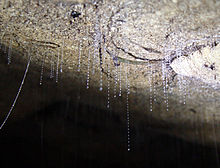Arachnocampa
| Arachnocampa | |
|---|---|
 |
|
| Two A. luminosa larvae with their prey snares |
|
| Scientific classification | |
| Kingdom: | Animalia |
| Phylum: | Arthropoda |
| Class: | Insecta |
| Order: | Diptera |
| Family: | Keroplatidae |
| Genus: | Arachnocampa |
| Species | |
|
|
|
| Synonyms | |
|
Bolitiphila |
|
Bolitiphila
Arachnocampa is a genus of five fungus gnat species which have a luminescent larval stage, akin to the larval stage of glowworm beetles. The species of Arachnocampa are endemic to New Zealand and Australia, dwelling in caves and grottos, or sheltered places in forests.
A previous synonym was "Bolitiphila," meaning "mushroom lover," in the past. The name was changed in 1924 to Arachnocampa, meaning "spider-worm," for the way the larvae hang sticky silk threads to ensnare prey. The genus Arachnocampa belongs in the family Keroplatidae.
Arachnocampa species have holometabolous metamorphosis with eggs, larvae, pupae, and adults. Individuals spend most of their lives as larvae.
These flies live from about 6 through 12 months as larvae, depending on food availability. A larva is only about 3-5 mm long when it emerges from its egg, and can grow up to about 3 cm long.
The larva spins a nest out of silk on the ceiling of the cave and then hangs down as many as 70 threads of silk (called snares) from around the nest, each up to 30 or 40 cm long and holding droplets of mucus. The larvae can only live in a place out of the wind, to stop their lines being tangled, hence caves, overhangs or deep rainforest. In some species, the droplets of mucus on the silk threads are poisonous, enhancing the trap's ability to subdue prey quickly.
A larva's glow attracts prey into its threads. The roof of a cave covered with larva can look remarkably like a blue starry sky at night. A hungry larva glows brighter than one that has just eaten. Prey include midges, mayflies, caddisflies, mosquitos, moths, and even small snails or millipedes. When a prey is caught by a snare, its larva pulls it up (at up to about 2 mm a second) and feeds on the prey. When Arachnocampa prey are scarce, larvae may show cannibalism, eating other larvae, pupae or adult flies.
...
Wikipedia
